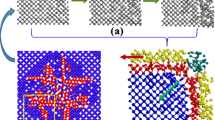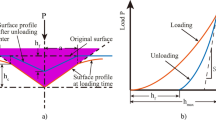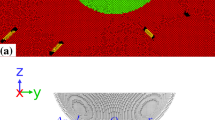Abstract
Exploring the accuracy of nanoindentation testing is especially important for determining the hardness and Young’s modulus values of materials. In this paper, molecular dynamics simulation was used to study the nanoindentation mechanism of three-body diamond abrasive grains rotating at various speeds on single-crystal silicon materials. An in-depth study of the three-body diamond abrasive nanoindentation single-crystal Si process, indentation stress, dislocation, crack propagation, coordination number, defect atoms, load, nanoindentation zone temperature, and potential energy changes is made. The results mean that the smaller the speed of rotation of the three-body abrasive grains, the greater the stress in all directions, and the more the dislocations that can be easily observed inside the workpiece. Moreover, the greater the rotational speed of the abrasive grains, the smaller the number of Si-II phase transitions in the workpiece; the number of defective atoms inside the workpiece after the three-body abrasive nanoindentation is greater than that in the case of two-body abrasive nanoindentation. In addition, the faster the abrasive grain rotation, the higher the temperature of the workpiece nanoindentation zone, the larger the potential energy, the more obvious the atomic motion inside the workpiece, and the greater the atomic motion inside the workpiece is biased toward the direction of rotation. In addition, the faster the grain rotation in three-body nanoindentation, the smaller the average load on the workpiece.







Similar content being viewed by others
References
M. Ge, H. Zhu, C. Huang et al., Investigation on critical crack-free cutting depth for single-crystal silicon slicing with fixed abrasive wire saw based on the scratching machining experiments. Mater. Sci. Semicond. Process. 74, 261–266 (2018)
J. Ruckman, H. Pollicove, D. Golini, Advanced manufacturing generates conformal optics: optoelectronics world: optics. Laser focus world 35(7), S13–S15 (1999)
T. Saga, Advances in crystalline silicon solar cell technology for industrial mass production. NPG Asia Mater. 2, 96–102 (2010)
B. Guo, Q. Zhao, X. Fang, Precision grinding of optical glass with laser micro-structured coarse-grained diamond wheels. J. Mater. Process. Technol. 214(5), 1045–1051 (2014)
B. Liang, Y. Liu, Y. Xu, Silicon-based materials as high capacity anodes for next generation lithium ion batteries. J. Power Sour. 267, 469–490 (2014)
Y. Xiao, C. Chen, S. Cao et al., Enhanced sunlight-driven photocatalytic activity of graphene oxide/Bi2WO6 nanoplates by silicon modification. Ceram. Int. 41(8), 10087–10094 (2015)
Y. Liu, Z. Tai, T. Zhou et al., An all-integrated anode via interlinked chemical bonding between double-Shelled–Yolk-structured silicon and binder for lithium-ion batteries. Adv. Mater. 29(44), 1703028 (2017)
W.C. Oliver, G.M. Pharr, An improved technique for determining hardness and elastic modulus using load and displacement sensing indentation experiments. J. Mater. Res. 7(6), 1564–1583 (1992)
J. Jang, G.M. Pharr, Influence of indenter angle on cracking in Si and Ge during nanoindentation. Acta Mater. 56(16), 4458–4469 (2008)
S.R. Jian, Mechanical deformation induced in Si and GaN under Berkovich nanoindentation. Nanoscale Res. Lett. 3(1), 6 (2008)
W. Yu, C.Y. Niu, Z. Zhu et al., Atomically thin binary V–V compound semiconductor: a first-principles study. J. Mater. Chem. C 4(27), 6581–6587 (2016)
D.K. Mishra, M. Meraj, S.K. BadJena et al., Dislocation interaction and V-shaped growth of the distorted structure during nanoindentation of Cu20Ni20Al20Co20Fe20 (high-entropy alloy)-coated copper: a molecular dynamics simulation-based study. Trans. Indian Inst. Met. 72(1), 167–180 (2019)
T. Fu, X. Peng, Y. Zhao et al., Molecular dynamics simulation of TiN (001) thin films under indentation. Ceram. Int. 41(10), 14078–14086 (2015)
S. Jiao, Q. Huang, W. Tu et al., Investigation on the phase transformation of monocrystalline silicon during nanoindentation at cryogenic temperature by molecular dynamics simulation. Physica B 555, 139–144 (2019)
S. Jiapeng, L. Cheng, J. Han et al., Nanoindentation induced deformation and pop-in events in a silicon crystal: molecular dynamics simulation and experiment. Sci. Rep. 7(1), 10282 (2017)
Z. Zhang, A. Stukowski, H.M. Urbassek, Interplay of dislocation-based plasticity and phase transformation during Si nanoindentation. Comput. Mater. Sci. 119, 82–89 (2016)
T. Fu, X. Peng, X. Chen et al., Molecular dynamics simulation of nanoindentation on Cu/Ni nanotwinned multilayer films using a spherical indenter. Sci. Rep. 6, 35665 (2016)
T. Fu, X. Peng, Y. Zhao et al., MD simulation of effect of crystal orientations and substrate temperature on growth of Cu/Ni bilayer films. Appl. Phys. A 122(2), 67 (2016)
Y. Pang, M. Springborg, Atomistic simulation of nanoindentation using the DFTB method. Comput. Mater. Sci. 118, 203–213 (2016)
Q. Zhao, Q. Zhang, S. To et al., Surface damage mechanism of monocrystalline Si under mechanical loading. J. Electron. Mater. 46(3), 1862–1868 (2017)
S. Wang, H. Liu, L. Xu et al., Investigations of phase transformation in monocrystalline silicon at low temperatures via nanoindentation. Sci. Rep. 7(1), 8682 (2017)
S. Goel, N.H. Faisal, X. Luo et al., Nanoindentation of polysilicon and single crystal silicon: molecular dynamics simulation and experimental validation. J. Phys. D Appl. Phys. 47(27), 275304 (2014)
Y.H. Lin, T.C. Chen, A molecular dynamics study of phase transformations in mono-crystalline Si under nanoindentation. Appl. Phys. A 92(3), 571 (2008)
J. Sun, L. Fang, J. Han et al., Phase transformations of mono-crystal silicon induced by two-body and three-body abrasion in nanoscale. Comput. Mater. Sci. 82, 140–150 (2014)
J. Han, J. Sun, S. Xu et al., Deformation mechanisms at multiple pop-ins under spherical nanoindentation of (1 1 1) Si. Comput. Mater. Sci. 143, 480–485 (2018)
J. Shi, X. Wei, J. Chen et al., Influence of abrasive shape on the abrasion and phase transformation of monocrystalline silicon. Crystals 8(1), 32 (2018)
L.C. Zhang, H. Tanaka, On the mechanics and physics in the nanoindentation of silicon monocrystals. JSME Int. J. Ser. A Solid Mech. Mater. Eng. 42(4), 546–559 (1999)
Y. Wang, S. Ruffell, K. Sears, A.P. Knights, J.E. Bradby, J.S. Williams, Electrical properties of Si-XII and Si-III formed by nanoindentation. In 2010 Conference on Optoelectronic and Icroelectronic Materials and Devices (COMMAD) (2010)
L. Zhang, H. Zhao, Y. Yang et al., Evaluation of repeated single-point diamond turning on the deformation behavior of monocrystalline silicon via molecular dynamic simulations. Appl. Phys. A 116(1), 141–150 (2014)
J.J. Gilman, Mechanism of shear-induced metallization. Czech J. Phys. 45(11), 913–919 (1995)
R.W. Cahn, Metallic solid silicon. Nature 357(6380), 645 (1992)
D. Chrobak, N. Tymiak, A. Beaber, O. Ugurlu, W.W. Gerberich, R. Nowak, Deconfinement leads to changes in the nanoscale plasticity of silicon. Nat. Nano 6(8), 480–484 (2011)
G.L.W. Cross, Silicon nanoparticles: isolation leads to change. Nat. Nano 6(8), 467–468 (2011)
W. Liu, Y. Wang, Y. Ma et al., Nanoindentation study on micromechanical behaviors of Au–Ni–Sn intermetallic layers in Au–20Sn/Ni solder joints. Mater. Sci. Eng. A 653, 13–22 (2016)
X. Zhou, B. Ouyang, W.A. Curtin et al., Atomistic investigation of the influence of hydrogen on dislocation nucleation during nanoindentation in Ni and Pd. Acta Mater. 116, 364–369 (2016)
M. Arif, M. Rahman, W.Y. San, Analytical model to determine the critical conditions for the modes of material removal in the milling process of brittle material. J. Mater. Process. Technol. 212(9), 1925–1933 (2012)
J. Chen, Q. Fang, P. Li, Effect of grinding wheel spindle vibration on surface roughness and subsurface damage in brittle material grinding. Int. J. Mach. Tools Manuf. 91, 12–23 (2015)
E. Bitzek, P. Gumbsch, Atomistic simulations of dislocation-crack interaction. J. Solid Mech. Mater. Eng. 2(10), 1348–1359 (2008)
H. Dai, S. Li, G. Chen, Molecular dynamics simulation of subsurface damage mechanism during nanoscratching of single crystal silicon. Proc. Inst. Mech. Eng. Part J: J. Eng. Tribol. 233(1), 61–73 (2019). https://doi.org/10.1177/1350650118765351
C.S. Moura, L. Amaral, Molecular dynamics simulation of silicon nanostructures. Nucl. Instrum. Methods Phys. Res. Sect. B 228(1–4), 37–40 (2005)
J. Tersoff, New empirical model for the structural properties of silicon. Phys. Rev. Lett. 56(6), 632 (1986)
F.H. Stillinger, T.A. Weber, Computer simulation of local order in condensed phases of silicon. Phys. Rev. B 31(8), 5262 (1985)
S. Goel, X. Luo, R.L. Reuben, Wear mechanism of diamond tools against single-crystal silicon in single point diamond turning process. Tribol. Int. 57, 272–281 (2013)
W.C.D. Cheong, L.C. Zhang, Molecular dynamics simulation of phase transformations in silicon monocrystals due to nanoindentation. Nanotechnology 11(3), 173 (2000)
Y. Wang, J. Shi, C. Ji, A numerical study of residual stress induced in machined silicon surfaces by molecular dynamics simulation. Appl. Phys. A 115(4), 1263–1279 (2014)
M.B. Cai, X.P. Li, M. Rahman, Study of the temperature and stress in nanoscale ductile mode cutting of silicon using molecular dynamics simulation. J. Mater. Process. Technol. 192, 607–612 (2007)
D.E. Kim, S.I. Oh, Atomistic simulation of structural phase transformations in monocrystalline silicon induced by nanoindentation. Nanotechnology 17(9), 2259 (2006)
R. Komanduri, N. Chandrasekaran, L.M. Raff, Molecular dynamics simulation of the nanometric cutting of silicon. Philos. Mag. B 81(12), 1989–2019 (2001)
K. Mylvaganam, L.C. Zhang, P. Eyben et al., Evolution of metastable phases in silicon during nanoindentation: mechanism analysis and experimental verification. Nanotechnology 20(30), 305705 (2009)
R.G. Jasinevicius, J.G. Duduch, P.S. Pizani, Structure evaluation of submicrometre silicon chips removed by diamond turning. Semicond. Sci. Technol. 22(5), 561 (2007)
H. Dai, G. Chen, C. Zhou et al., A numerical study of ultraprecision machining of mono-crystalline silicon with laser nano-structured diamond tools by atomistic simulation. Appl. Surf. Sci. 393, 405–416 (2017)
J. Sarkar, D.K. Das, Nanoindentation study of mechanical behavior and response of a single layer pristine silicene sheet using molecular dynamics simulations. Comput. Mater. Sci. 147, 64–71 (2018)
Acknowledgements
The authors would like to appreciate the fund project for the introduction of talents in Guizhou University (No. [2017]24), Guizhou Province Education Department Youth Science and Technology Talent Growth Project (No. [2018]110), and National Natural Science Foundation cultivation project for young teachers of Guizhou University (No. [2017]5788).
Author information
Authors and Affiliations
Corresponding author
Additional information
Publisher's Note
Springer Nature remains neutral with regard to jurisdictional claims in published maps and institutional affiliations.
Rights and permissions
About this article
Cite this article
Dai, H., Zhang, F., Zhou, Y. et al. Numerical study of three-body diamond abrasive nanoindentation of single-crystal Si by molecular dynamics simulation. Appl. Phys. A 125, 348 (2019). https://doi.org/10.1007/s00339-019-2643-4
Received:
Accepted:
Published:
DOI: https://doi.org/10.1007/s00339-019-2643-4




